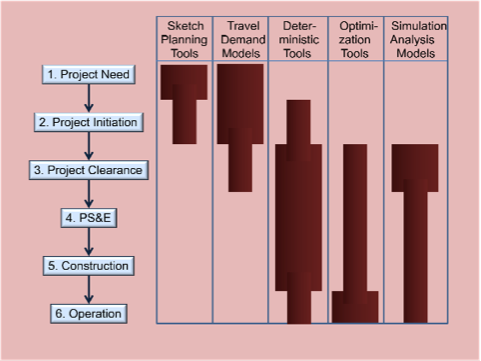FEDERAL HIGHWAY ADMINISTRATION
EXECUTIVE SUMMARY
The Federal Highway Administration (FHWA), in support of the Traffic Analysis and Simulation Pooled Fund Study (PFS), initiated this study to identify and address consistency in the selection and use of traffic analysis tools. This document offers recommendations on the management, planning, and conduct of traffic analysis that will promote greater traffic analysis tool consistency over the typical project development life cycle. It is directed toward professionals operating in State departments of transportation and other agencies responsible for transportation project development and delivery.
The purpose of this guidebook is to provide technical advice on the selection and use of traffic analysis tools and methods in a manner that promotes consistency over the course of the project development life cycle. Terminology and processes contained in this guidebook are a composite of the experiences of and approaches used by transportation agencies across the country for instructive and consistency purposes. When using this guidance, individual agencies will need to consider how their own terminology, processes, and procedures correspond to those contained in this document.
ANALYSIS TOOLS AND THE PROJECT DEVELOPMENT LIFE CYCLE
A transportation improvement project typically goes through the following stages of development:
1. Project need identification.
2. Project initiation.
3. Project clearance.
4. Plans, specifications, and estimates (PS&E).
5. Construction.
6. Operation.
In the early stages of project development, relatively little has been defined about the project. Consequently, the analysis has to be relatively broad and comprehensive, with the focus of the analysis increasing as the project and its alternatives are defined in the later stages.
The following categories of traffic analysis tools are available for evaluating a transportation improvement project:
- Sketch-planning tools.
- Travel demand models.
- Analytical/deterministic tools (based on the Highway Capacity Manual (HCM)).
- Traffic signal optimization tools.
- Simulation models (macroscopic, mesoscopic, and microscopic).
Figure 1 shows the optimal application ranges for each of the traffic analysis tool types. A wide vertical band indicates that the project development stage falls within the range of application for which the tool is best suited. A thin vertical band indicates that the tool can be used for that stage of project development but is less well-suited for that application.
 Figure 1. Chart. Traffic analysis tool application ranges in project development.
Figure 1. Chart. Traffic analysis tool application ranges in project development.
About the Federal Highway Administration
www.fhwa.dot.gov
“The Federal Highway Administration (FHWA) is an agency within the U.S. Department of Transportation that supports State and local governments in the design, construction, and maintenance of the Nation’s highway system (Federal Aid Highway Program) and various federally and tribal owned lands (Federal Lands Highway Program). Through financial and technical assistance to State and local governments, the Federal Highway Administration is responsible for ensuring that America’s roads and highways continue to be among the safest and most technologically sound in the world.”
Tags: Federal Highway Administration, FHWA, Traffic, traffic analysis tools, transportation






 RSS Feed
RSS Feed